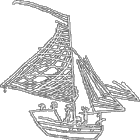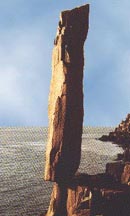
 |
 |
 |
 |
Nova Scotia has a long geological history dating back over a billion years. The rocks found on land date back as far as 1.4 billion years. The rocks offshore date back about 250 million years and show records of mountain building and erosion, earthquakes, volcanic eruptions and the collision of the continents. During the early Devonian period, about 400 million years ago, Nova Scotia was actually part of the African continent.
The geographic area of Digby and Annapolis Counties exhibits a wide cross section of land formations, geological deposits and features. The North and South Mountain ranges were formed over 2000 years ago and have been shaped by the forces of erosion ever since.
Between these two mountain ranges winds the Annapolis River and the fertile soils of the Annapolis Valley. The Annapolis River empties into the Annapolis Basin and is heavily influenced by the power of the tides. This can be seen in the meandering nature of the river. Inland, one can find evidence of the power of glaciers. The area has numerous drumlins (many within Kejimkujik and Tobeatic Wilderness Preserve), you may also notice large boulders which appear to be out of place, rising out of the middle of lakes or in the woods. These were deposited by retreating glaciers many years ago and now often act as landmarks for people hiking and canoeing the back country.
Balancing Rock, Long Island Our landscape was not just affected by glaciers, but also by our coastal location and the power of the world's highest tides. These factors combined over time to give us the variety of physical and geological features as well as habitats that you may experience here today. Along with the two mountain ranges and the river valley you will also find cobble beaches, coastal cliffs, both salt and freshwater marshes, tidal flood plains drumlands, glacier formed rivers and lakes, and the uniqueness of the Digby Neck and Islands formation.

